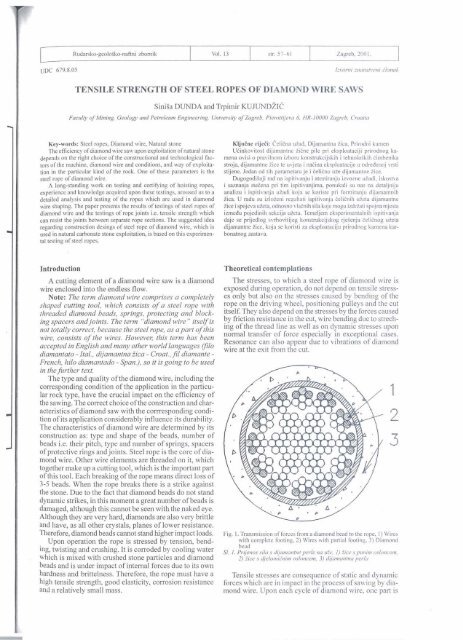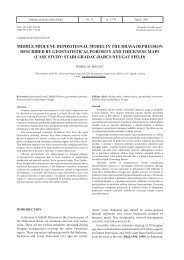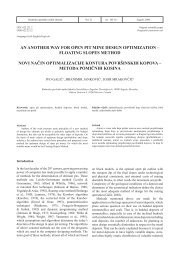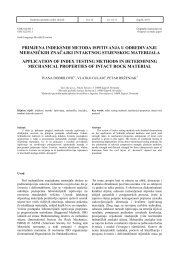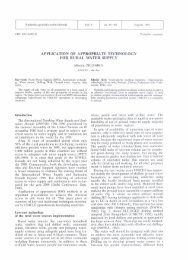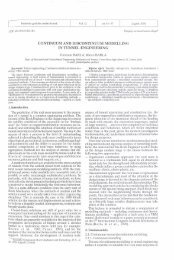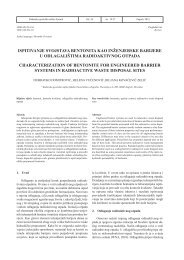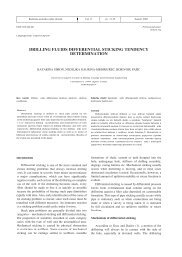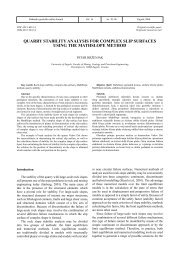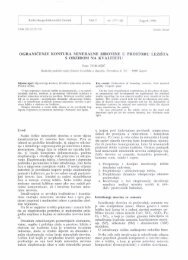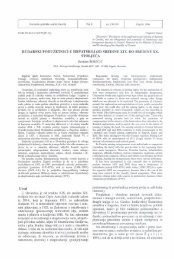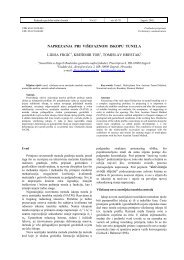TENSILE STRENGTH OF STEEL ROPES OF DIAMOND WIRE SAWS
TENSILE STRENGTH OF STEEL ROPES OF DIAMOND WIRE SAWS
TENSILE STRENGTH OF STEEL ROPES OF DIAMOND WIRE SAWS
- No tags were found...
Create successful ePaper yourself
Turn your PDF publications into a flip-book with our unique Google optimized e-Paper software.
Zagreb, 200 1.<strong>TENSILE</strong> <strong>STRENGTH</strong> <strong>OF</strong> <strong>STEEL</strong> <strong>ROPES</strong> <strong>OF</strong> <strong>DIAMOND</strong> <strong>WIRE</strong> <strong>SAWS</strong>Siniga DUNDA and Trpimir KUJUND~ICFaculfy of Mining, Geology and Petroleum Engineering, Universily of Zagreb, PieroN!jeieva 6, HR-10000 Zagreb, CroatiaKey-words: Steel ropes, Diamond wire, Natural stoneThe efficiency of diamond wire saw upon exploitation of natural stonedepends on the right choice of the constructional and technological factorsof the machine, diamond wire and conditions, and way of exploitationin the particular kid of the rock. One of these parameters is thesteel rope of diamond wire.A long-standing work on testing and certifying of hoisting ropes,experience and knowledge acquired upon these testings, aroused us to adetailed analysis and testing of the ropes which are used in diamondwire shaping. The paper presents the results of testings of steel ropes ofdiamond wire and the testings of rope joints i.e. tensile strength whichcan resist the joints between separate rope sections. The suggested idearegarding construction desings of steel rope of diamond wire, which isused in natural carbonate stone exploitation, is based on this expermentaltesting of steel ropes.KljuEne rijeEi: CeliEna uiad, Dijamantna iica, Prirodni kanlenUEinkovitost dijarnantne ZiEne pile pri eksploataciji prirodnog kamenaovisi o pravilnom izboru konstrukcijskih i tehnoloSkih Eimbenikastroja, dijamantne tice te uvjeta i naEina eksploatacije u odredenqj vrstistijene. Jedan od tih parametara je i Eelitno ute dijarnantne ?ice.DugogodiSnji rad na ispitivanju i atestiranju izvozne uhdi, iskustvai saznanja stekna pri tim ispitivanjima, ponukali su nas na detaljnijuanalizu i ispitivanja uiadi koja se koriste pri forrniranju dijamantnihZica. IJ radu su izloteni rezultati ispitivanja EeliEnih uieta dijamantnetice i spojeva uieta, odnosno vlaEnih sila koje rnogu izdriati spojna mjestaizmedu pojedinih sekcija uteta. Terneljem eksperirnentalnih ispitivanjadaje se prijedlog svrhovitijeg konstrukcijskog rjeSenja EeliEnog uietadijamantne Zice, koja se koristi za eksploataciju prirodnog kamena karbonatnogsastava.IntroductionA cutting element of a diamond wire saw is a diamondwire enclosed into the endless flow.Note: The term diamond wire comprises a completelyshaped cutting tool, which consists of a steel rope withthreaded diamond beads, springs, protecting and blockingspacers and joints. The term "diamond wire" itself isnot totally correct, because the steel rope, as apart of thiswire, consists of the wires. Howevel; this term has beenaccepted in English and many other world languages @lodiamantato - Ital., dgamantna iica - Croat., Jil diamante -French, hilo diamantado - Span.), so it is going to be usedin thejitrther text.The type and quality ofthe diamond wire, including thecorresponding condition of the application in the particularrock type, have the crucial impact on the efficiency ofthe sawing. The correct choice of the construction and characteristicsof diamond saw with the comesponding conditionof its application considerably influence its durability.The characteristics of diamond wire are determined by itsconstruction as: type and shape of the beads, number ofbeads i.e. their pitch, type and number of springs, spacersof protective rings and joints. Steel rope is the core of diamondwire. Other wire elements are threaded on it, whichtogether make up a cutting tool, which is the important partof this tool. Each breaking of the rope means direct loss of3-5 beads. When the rope breaks there is a strike againstthe stone. Due to the fact that diamond beads do not standdynamic strikes, in this moment a great number of beads isdamaged, although this cannot be seen with the naked eye.Although they are very hard, diamonds are also very brittleand have, as all other crystals, planes of lower resistance.Therefore, diamond beads cannot stand higher impact loads.Upon operation the rope is stressed by tension, bending,twisting and crushing. It is corroded by cooling waterwhich is mixed with crushed stone particles and diamondbeads and is under impact of internal forces due to its ownhardness and brittelness. Therefore, the rope must have ahigh tensile strength, good elasticity, corrosion resistanceand a relatively small mass.Theoretical contemplationsThe stresses, to which a steel rope of diamond wire isexposed during operation, do not depend on tensile stressesonly but also on the stresses caused by bending of therope on the driving wheel, positioning pulleys and the cutitself. They also depend on the stresses by the forces causedby friction resistance in the cut, wire bending due to strechingof the thread line as well as on dynamic stresses uponnormal transfer of force especially in exceptional cases.Resonance can also appear due to vibrations of diamondwire at the exit from the cut.Fig. I. Transmission of forces from a diamond bead to the rope, I) Wireswith complete footing, 2) Wires with partial footing, 3) DiamondbeadSl. I. Prijenos silo .r dijumantne perle nu &e. I) iice s punirn osloncem.2) iice s djelomidnim osloncem. 3) dijumantna perlaTensile stresses are consequence of static and dynamicforces which are in impact in the process of sawing by diamondwire. Upon each cycle of diamond wire, one part is
Rud.-geo1.-naR. zb., Vol. 13, Zagreb. 2001Dunda, S. & Ku]undicC, T. Diamond wire sawsin the cut and passes along its bended and rectilinear parts,while the other part is outside the cut and passes along thedriving pulley and positioning pulleys. The rope is constantlystressed also on bending, which causes deteriorationof material and breaking of wires. The rope is not indirect contact with these planes, so the forces are transferredto it via beads by means of surface wire layer in onlyone part of the circumference (Fig. 1). Thanks to the frictionbetween the wires the force is transferred and distributedon the other wires of the rope. This also means thatthe wire contacts rub, deteriorate and decrease the metalcrosssection. Upon bending of diamond wire in the cut (especiallywhen the cut dimensions are small) of the drivingpulley or pulleys, the surface wires of the rope must belengthened (Fig. 2), which means again that the parts ofone wire will move relatively in relation to the wire standingnearby, with which this wire is in contact (pointwise orlinear). After passing over the curve the lengthened part ofthe rope is "coming back" and wires are again moving relativelyin relation to one another, rubbing and deteriorating.The crossing of the wires in the specific strand or thecrossing of surface wires in the nearby standing strands areespecially unfavourable. Crushing appears on such a (pointwise)contact, which in combination with relative movementand rubbing causes intensive local deterioration i.e.decrease of the cross-section.The testings of the deteriorated ropes have pointed tothe causes of decrease of tensile, torsion and bendingstrengths. The main cause of wire deterioration appearedto be corrosion, rubbing and crushing of the rope. Theseare also the places of the reduced wire resistance. It wasdetermined that the wire joints are especially sensitive elementsof diamond wire. The sudden changes of tensilestrengths and the sudden repeated axial impacts, whichappear upon the start-up of the saw after the break, havethe highest effect on the links of the particular rope sections.These are therefore critical areas especially when thesawing angles are more acute. In order to find out if thereis and how much is the difference between breaking loadof the rope and braking load of the joint on the rope weconducted additional laboratory testings, the results ofwhich are presented in this paper.Testings offhe breaking load of the rope aadjointsThe former testings comprised testing of various typesand constructions of ropes, which are used to form a diamondwire. In the meantime most of the users in Croatiahave accepted the round strand rope as the most useful one(Fig. 3) with constructions (1+6+12)+6(1+6). This ropeconstruction proved as the best one in former testings too.Therefore, these testings comprised determination of breakingload of the rope of this construction and breaking loadof the same ropes connected by two kinds of joints. Theropes made by 4 manufacturers were tested and sleeve couplingsand joints with amale-female" threads wereused forconnecting. Connecting was done on a standard devicewhich is used upon shaping of diamond wire (diamond wirebench assembling unit) by the workers of particular usersin the way as they do it for their everyday use. Although allthe ropes had the same bacis construction they differedamong each other to a certain extent in the strength of steeland minor construction details.Fig. 2. Passing of the rope along the curvatureS 2. Prijelaz &eta preko zakrivljenjaThe elasticity of the rope must be extremely high, becausethe entire diamond wire must be extremely elastic.The hardness of the entire wire is increased by its shaping,i.e. putting of diamond beads, strings, rings and spacers.The elements which are threaded on the rope are free andare turning around the rope, which is facilitated by the bendingof some rope parts upon operation, which requires torsionstrength of the rope.Experimental workIn the company Jadrankamen-PuCiSCa (the island ofBraE) the consumption of different rope types was observedin order to determine the characteristics of diamond wirerope and changes of these characteristics after the operationwithin a certain period of time. The observed ropeswere tested in the laboratory after samples were taken fromthe new ropes and the same ropes after particular ones hadto be replaced due to deterioration. After a detailed visualexaminations the testings of breaking strength, bending andtwisting of the rope were also conducted. The results ofthese testings were presented at the 10th International Conference:Investigation, Production and Use of Steel WireRopes - Slowakia, 1998. (D u n d a, 1998).Fig. 3. Cross-section of the tested ropesSI 3 Presjek ispitivanih &etaIn these testings the real breaking load was only determinedby breaking of the rope as a whole, in difference tothe earlier testings, when this load was determined by tesfingof specific wire samples and summing up their values.Upon the testing of the rope by its breaking as a wholeappears gradual breaking of some wires within specificforce and loosening of the strength (Fig. 4). The indicatorof the testing instruments registers the load which causesthe damages of some wires, not the rope braking. This loadis regarded as relevant for determination of the allowedtensile strengths.
I -~ud.-geol.-nafi. zb., Vol. 13, Zagreb, 2001Dunda, S. & Kujundiii., T.: Diamond wire saws.IIFig. 4. Way of rope breakingS. 4. Na&in prekida &etaDuring the testings of breaking load ofrope joints break- cases the ropes broke along the edge of the joint (Fig. 6).ing was in most cases caused by pulling out of the rope Strictly speaking, during the testings ofjoints with "malefromthe joint (Fig. 5), whilst only in a small number of -female9' thread the rope was pulled out from the joint inFig. 5. The most common way of breaking of rope jointsS, 5. NajEe3i.i nutin prekih spojnih mjesra &etaTable 1 Concise results of testings of breaking load of ropes and jointsTablica I Saieti rezultati ispitivanja prekidnih sila &a i spojnica<strong>ROPES</strong> NO.Minimum breaking load, NMaximum breaking load, NAverage breaking load, NLTHREADED JOINTS ON <strong>ROPES</strong> NO,Minimum breaking load, NMaximum breaking load, NAverage breaking load, NSLEEVE COUPLINGS ON <strong>ROPES</strong> NO.Minimum breaking load, NMaximum breaking load, NAverage breaking load, N1172601829017898144926 1004 80511 7463 7853 4622122591436713 779249046 8655 9542---3158381721116721345216 4735 37433 1703 3103 240415966164761605144 8656 3605 2604--1
Rud.-geol.-naft. zb., Vol. 13, Zagreb, 2001Dunda, S. & KujundiiE, T: Diamond wire saws86.6% cases and in 13.4% cases the rope broke along theedge of the joint, while the rope was pulled out from allthe sleeve couplings.The concise results of the testings of breaking load ofdiamond wire ropes and joints on them are presented in theTable 1. The names of specific rope manufacturers are notstated in the Table but they are replaced by the numbers1,2,3 and 4. 25 rope samples (total of 100) were testedfrom each manufacturer including the total of 100 jointswith L'male-female" threads and 50 sleeve couplings. Theaverage figures of breaking load of the rope and jointspresent the mean value of 23 tested samples, because thelowest and the highest values are not included in this averagevalue.Fig. 6. A more rare way of breaking of rope jointsSf. 6. Rjedi naEin prekida spojnih rnjesta uietaAnalysis of the resultsThe results of the testings (Tab. 1) show that the steelrope of diamond wire, which is used upon sawing of carbonatestone, can resist to approx. 3 times higher tensilestrength than the joints connected by "male-female" threadsand approx. 5 times higher strength than the joints connectedby sleeve couplings. Upon testing of complete ropebreaking the average breaking load was 17 898 N for theropes no. 1,13 779 N for the ropes no. 2,16 72 1 N for theropes no. 3 and 16 051 N for the ropes no. 4. The highestaverage value of breaking loads of joints with "male-female"threads was only 5 954 N (ropes no. 2) and 3 462 N(ropes no. 1) for the joints connected by sleeve couplings.These testings clearly show that the rope can resist to aconsiderably higher breaking load than the joints can. Accordingly,the critical points of breaking are joints too, notjust ropes. This means that it is not necessary to have ropesof high breaking load. More important is for them to be aselastic as possible. Therefore, the softer wire material canadditionally increase the rope elasticity.The diamond wire rope must have a small cross-sectionand mass but high tensile strength. Such a rope must beelastic and resistant to crushing, torsion, abrasion and corrosion.It is very difficult to select the rope constructionwhich meets all the requirements at the same time, sincesome of them exclude one another. The wires of larger diameterhave higher tensile strength but lower bendingstrength at the same time and V.V. By increase of wire hard-ness the tensile strength is increased, but the bendingstrength is decreased. The tougher material is, the rope isharder and more brittle (the interdependence is not proportionalbut appears in lower progression). Since the ropejoints have considerably smaller breaking resistance thanthe rope itself, it is useful to use the ropes of lower tensilestrength, which at the same time increases its bendingstrength.During the testings of joints the breaking on the jointwas in most cases caused by the pulling out of the ropefrom the joint. This brings us to the conclusion that thebreaking load of the joint can be increased by better fasteningof the joints, i.e. larger pressing upon their fastening.However this is denied by other samples, whereby disconnectionwas caused by breaking of ropes along the edgeofthe joint. Tensile strengths, which caused such breaking,were the same or lower than those, which caused pullingout of ropes from the joints. This means that fastened jointswith larger pressing cause squeezing and loosing of ropesat the joint, which again means that fastening ofjoints withlarger pressing will not enlarge resistance to breaking ofthe joint.The testing results show that the ropes, which are usedfor shaping of diamond wires, can resist to high breakingload (they have a high pulling strength) i.e such high resistanceto breaking is not necessary since the joints betweenseparate rope sections cannot resist to this breaking loadanyway. This conclusion is proved by additional testingsthat we conducted on used ropes. These ropes resisted toapproximately the same (in some cases even higher) breakingloads as the new ropes, although the control of the sarnplesshowed that in each sample there was a considerablenumber (8-17%) of broken wires.The changing tensile strength, bending, rubbing andcrushing finally cause breaking of some rope wires. Despitethe fact that the broken wire presents the correspondingdecrease of the metal cross-section (and safety) of therope on the breaking point, due to the rubbing it takes overits part of the force in the rope on the particular length.Therefore the broken wire has along its length the limitedimpact on the tensile resistance of the rope as a whole.ConclusionUpon operation diamond wire as a whole and diamondwire rope were stressed by tension, exposed to static anddynamic friction forces as well as to constant bending oversmall radius of curvature. The rope was also exposed tocorrosion and deterioration. The stresses by kinetic impactswere unpleasant. High velocities of diamond wires producealso vibrations of the rope, caused by dynamic forces, whichlead to fatigue and recrystallisation of steel. Material fatigueis increased due to the uninterrupted sawing process,because wire material cannot have complete elastic deformations.Laboratory testings of breaking loads of ropes of diamondwire saws and joints on ropes showed that the ropecan resist to a manifold higher breaking load than the jointscan. Former trial testings of the ropes (Dun d a, 1998)have showed that the increased deterioration of diamondwire is mostly caused by partially too heavy stressing, sincethe rope is not with its entire surface in contact with thedriving pulley, leading pulleys and cutting surface. Thebeads on the rope are in contact with the coating of thedriving pulley, so only some parts of the wire in the roperesist upon the inner ring of the bead. Therefore appearsthe partial stress and wire crushing which causes the deformationof the rope and its too early deterioration. This isthe reason why the rope should be softer and more rounded
Rud-geo1.-naft. zb., Vol. 13, Zagreb, 2001mda, S.& KujundiiC, Z. Diamond wire sawswith decreased internal friction, which appears upon bendingin the cut and passing along the pulleys and drivingpulley. If the rope had stiffly braided harnpen core of appropriatedimensions, it would increase its softness andreduce the fi-iction and stress of the wires upon one another.However, it was thought that the application of the ropeswith hampen core on diamond wire saw was not purposefulsince such a rope has a decreased metal cross-section.Small diameter of diamond wire rope has already a smallmetal crosssection, so its additional decrease would substantiallyreduce the breaking load ofthe rope. The ratio ofthe metal cross-section and the cross-section of the circumscribedcircle around the cross-section of the normal strandropes with hampen core is approx. 0.47 and approx. 0.75with spiral strand ropes. The presented laboratory testingsof breaking load of ropes and joints show that even a ropewith such reduced cross-section would have sufficient i.e.higher breaking load than the joint. This means that standardstranded ropes for general purpose (DIN 3055, DIN3060) consisting of 6 rounded strands arranged concentricallyaround hampen core could be used as ropes of diamondwire saws (Fig. 7). Hampen core serves as elastic"placenta" and a reservoir of grease for strands and wires,which also influences the extension of durability of ropes.the strands would not have any purpose. However, the emptyspaces among strands in these spiral strand ropes cause theincreased friction and stress of the wires upon one another.Therefore we think that the construction of the rope, whichwould have hempen (or even better synthetic) fibre fillingwould show longer durability than the existing ropes. Suchpossible rope construction (Fig. 8) would not be differentthan the existing ones, except the fact that it would havesynthetic fibres of a small cross-section as a filler. Thesefillers would increase the homogenity of the rope, thestrands would not have punctual contact, but the contactsurface would be spread on the synthetic inserts, whichwould decrease crushing caused by the elements of the diamondwire (especially beads). This is especially visible uponbending along a small radius of curvature. Synthetic fibreswould take over the role of the hempen core to some extentby making the rope softer, but they would not reduce itsload bearing capacity, because the metal cross-sectionwould remain the same. The increased softness of the ropewould reduce the internal friction upon bending along thepulleys and in the cut, which would decrease deteriorationand prolong the durability of the rope.Fig. 7. Suggested standard stranded ropes with hampen core [(i+6(1+6)]and li+6(1+6+12)1Since diamond wire rope is small in diameter (5mm) itis certain that spiral ropes will further be used in a considerablenumber of cases. The results of the presented testing~show that the wires of such ropes should be made ofsofter steel. In our opinion the ropes should be constructedwith fillers. The ropes with round strands have emptinessin the strands which decreases the homogenity of the rope.In order to reduce the squeezing of the wires in the rope,which is the consequence of these empty spaces, thin fillerwires are put among the wires (with some constructions),but they are not load bearling wires. This enables bettercontact of the wires in strands and better elasticity of therope. The diamond wire rope has smaller empty spaces inthe strands because of the small wire cross-sections (smallerthan the usual ones in the filler wires), so the wire filling ofFig. 8. Proposal of a new construction of ropes for diamond wire, 1) steelwire, 2) synthetic fibre, 3) diamond beadsSI. 8. Prijedlog nove konshvkcije &eta za dijamantnu iicu, I) EeliEnaiica, 2) sintetifka nit, 3) dijamantne perleReceived: 2000-1 2-1 4Accepted: 2001-10-23REFERENCESDunda,S.&KujundZiC,T.(1998):SteelRopesofDiamondWireSaws. 10th International Conference: Investigation, Production andUse of Steel Wire Ropes '98. Procedings, 163-170, Podbanske(Slowakia).


